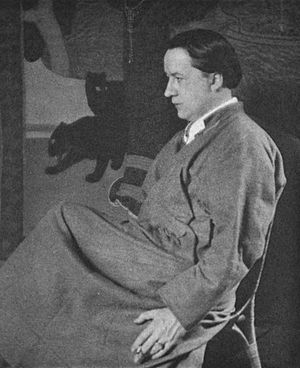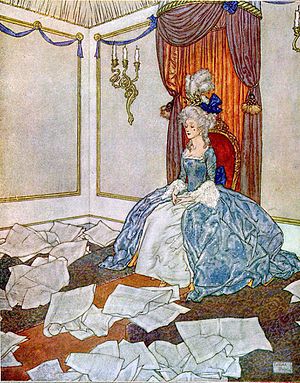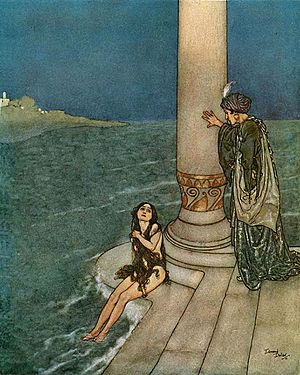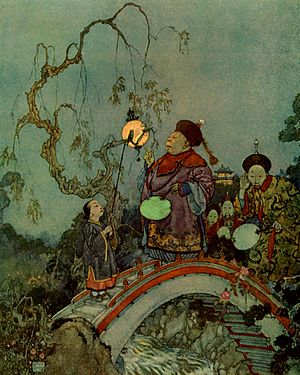Edmund Dulac facts for kids
Quick facts for kids
Edmund Dulac
|
|
|---|---|

Edmund Dulac, 1914
|
|
| Born |
Edmond Dulac
22 October 1882 |
| Died | 25 May 1953 (aged 70) |
| Nationality | French-British |
| Education | Ecole des Beaux Arts; Académie Julian |
| Known for | Painter, illustrator |
| Movement | Orientalist |
Edmund Dulac (born Edmond Dulac; 22 October 1882 – 25 May 1953) was a talented artist. He was a French British illustrator who designed pictures for magazines and books. He also created designs for postage stamps.
Dulac was born in Toulouse, France. He first studied law, but later decided to study art. He moved to London in the early 1900s. In 1905, he got his first job illustrating books. These were the novels written by the Brontë Sisters. During World War I, Dulac made special books to help raise money. After the war, he started illustrating magazines and doing other art projects. He even designed banknotes during World War II. He is also famous for designing postage stamps, especially those for Queen Elizabeth II when she became queen.
Contents
Early Life and Art Career



Edmund Dulac was born in Toulouse, France. He started by studying law at the University of Toulouse. But he found law boring. He loved art more and had won prizes at the École des Beaux-Arts. So, he switched to studying art full-time. In 1904, he spent a short time at the Académie Julian in Paris. Soon after, he moved to London.
When Dulac arrived in London, he was 22 years old. A publisher named J. M. Dent asked him to illustrate Jane Eyre. He also illustrated nine other books by the Brontë sisters. Dulac then started working regularly for The Pall Mall Magazine. He joined the London Sketch Club. This club helped him meet other famous book and magazine illustrators.
Through these connections, he began working with the Leicester Galleries and Hodder & Stoughton. The gallery would ask Dulac to create illustrations. They would then sell these original artworks in an annual show. Hodder & Stoughton bought the rights to print these pictures in special gift books. They published one book with his illustrations every year.
Some of the famous books Dulac illustrated include:
- Stories from The Arabian Nights (1907) with 50 colorful pictures.
- William Shakespeare's The Tempest (1908) with 40 colorful illustrations.
- The Rubaiyat of Omar Khayyam (1909) with 20 colorful pictures.
- The Sleeping Beauty and Other Fairy Tales (1910).
- Stories from Hans Christian Andersen (1911).
- The Bells and Other Poems by Edgar Allan Poe (1912) with 28 colorful pictures.
- Princess Badoura (1913).
Dulac became a British citizen on February 17, 1912. This meant he was officially a citizen of Britain.
During World War I, Dulac helped create books to raise money for war efforts. These included King Albert's Book (1914) and Princess Mary's Gift Book. He also made his own book, Edmund Dulac's Picture-Book for the French Red Cross (1915). This book had 20 colorful illustrations.
Later Career
After World War I, fancy illustrated books became less popular. This meant Dulac's career in that area changed. His last big illustrated books were Edmund Dulac's Fairy Book (1916) and Tanglewood Tales (1918). But Dulac found new ways to use his artistic skills.
He started drawing funny pictures for newspapers, especially for The Outlook. He also painted portraits of people. He designed costumes and sets for plays in the theatre. Dulac created designs for bookplates, chocolate boxes, and medals. He also made various graphics for The Mercury Theatre, Notting Hill Gate.
Dulac also drew illustrations for The American Weekly. This was a Sunday newspaper section in America and Britain. He also worked for Britain's Country Life magazine. Gods and Mortals in Love (1935) was a book that used many of Dulac's illustrations from Country Life. Another book, The Daughter of the Stars (1939), also featured his art. However, because World War II had started, it only had two color pictures. Dulac continued to illustrate books throughout his life. He created more books than many artists of his time.
Edmund Dulac was working on his final book, Milton's Comus, when he passed away. He died from a heart attack on May 25, 1953, in London.
Stamp Design
Edmund Dulac designed many postage stamps for Great Britain. He designed the stamp for the Coronation of King George VI. This stamp was released on May 13, 1937. He also designed the King's head that appeared on all stamps during that king's reign. Dulac also designed the 2s 6d and 5s values for the 'arms series' of high-value stamps. He helped create designs for stamps celebrating the 1948 Summer Olympics and the Festival of Britain.
Dulac was one of the artists who designed the Wilding series stamps. These were the first regular stamps for Queen Elizabeth II. He designed the border around the Queen's picture for some of these stamps. His own drawing of the Queen was not used. Instead, a photograph by Dorothy Wilding was chosen. Dulac then made some small changes to this photograph by hand. He also designed the 1s 3d stamp for Queen Elizabeth II's coronation. Sadly, he died just before this stamp was released.
During World War II, Dulac designed stamps and banknotes for Free France. In the early 1940s, he also worked on a design for a Polish 20-zlotych banknote. This banknote was ordered by the Polish Government in Exile. It was printed in England in 1942 but dated 1939. However, it was never actually used.
Books Illustrated by Dulac
- Bronte, C. - The Novels of the Bronte Sisters, Dent 1905
- Stawell, M. M. - Fairies I Have Met, Lane 1907
- ____ Stories from the Arabian Nights, Hodder & Stoughton, London, 1907
- Dulac, E. - Lyrics, Pathetic and Humourous from A to Z, Warne 1908
- Shakespeare, W. - The Tempest, Hodder & Stoughton, London, 1908
- ____ The Rubaiyat of Omar Khayyam, Hodder & Stoughton, London, 1909
- Couch, A. T. Q. - The Sleeping Beauty, Hodder & Stoughton, London, 1910
- ____ Ali Baba and other stories, Hodder & Stoughton, London, 1911
- ____ The Magic Horse, Hodder & Stoughton, London, 1911
- Andersen, H. C. - Stories from Hans Andersen, Hodder & Stoughton, London, 1911
- Poe, E. A. - The Bells, and other poems, Hodder & Stoughton, London, 1912
- ____ Princess Badoura, Hodder & Stoughton, London, 1913
- Stawell, M. M. - My Days With the Fairies, Hodder & Stoughton, London, 1913
- ____ Sindbad the Sailor and other stories, Hodder & Stoughton, London, 1914
- Dulac, E. - Edmund Dulac's Picture Book, Hodder & Stoughton, London, 1915
- Mary, Queen of Roumania The Dreamer of Dreams, Hodder & Stoughton, London, 1915
- Dulac, E. - Edmund Dulac's Fairy Book, Hodder & Stoughton, London, 1916
- Hawthorne, N. - Tanglewood Tales, Hodder & Stoughton, London, 1918
- Rosenthal, L. - The Kingdom of the Pearl, Nisbet 1920
- Yeats, W. B. - Four Plays for Dancers, Macmillan 1921
- Beauclerk, H. de V. - The Green Lacquer Pavilion, Collins 1926
- Yeats, W. B. - A Vision, Laurie 1926
- Stevenson, R. L. - Treasure Island, Benn 1927
- ____ A Fairy Garland, Cassell 1928
- Williamson, H. R. - Gods and Mortals in Love, Country Life 1935
- Cary, M. - The Daughter of the Stars, Hatchard 1939
- Milton, J. - Comus, Limited Edition Club, Cambridge 1949
- Alexander Pushkin, - The Golden Cockerel, The Heritage Press, published in 1950. Dulac wrote the version in English of Pushkin's tale used in the book. In addition to the illustrations, he designed the layout of the book, page by page.
Images for kids




